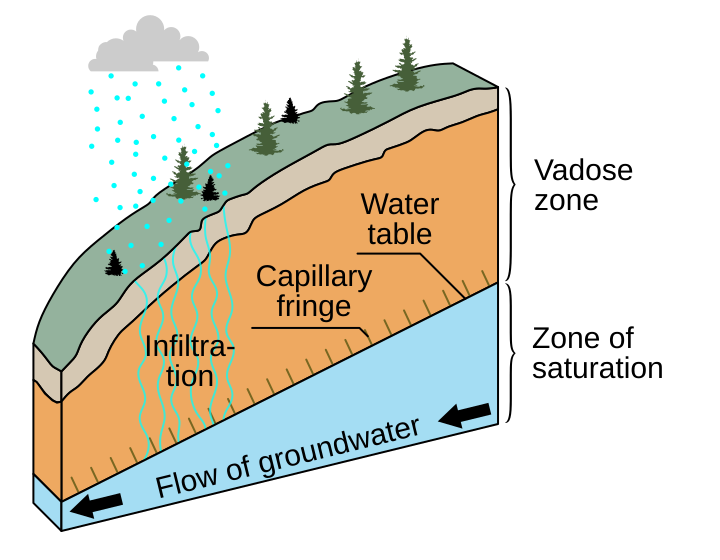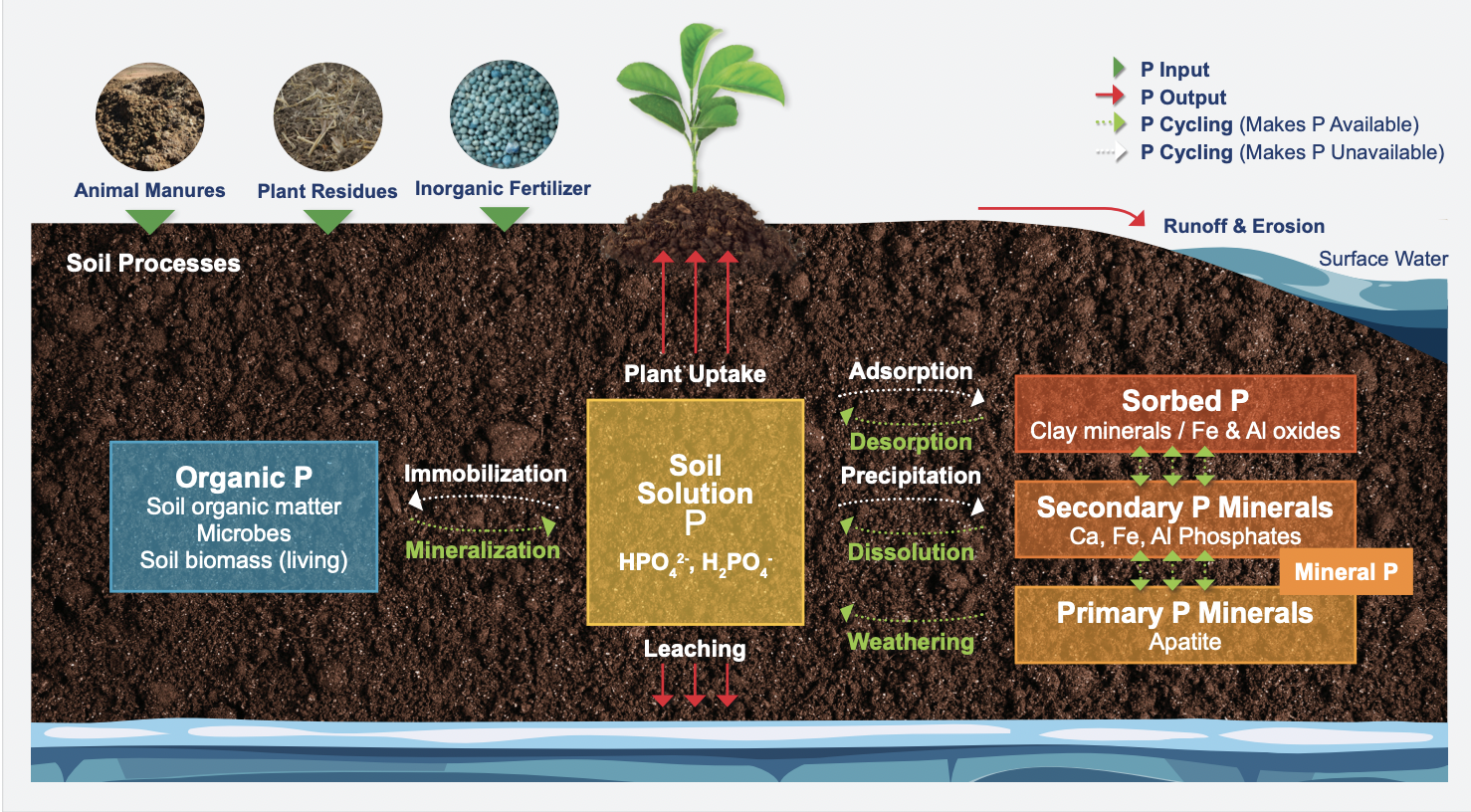IB Syllabus focus:
‘Inputs include litter, dead biomass, minerals, precipitation and anthropogenic additions. Transfers: infiltration, percolation, mixing, aeration, leaching, erosion. Transformations: decomposition, weathering, nutrient cycling and salinization.’
Soils are active, living systems where constant inputs, transfers, and transformations interact to sustain fertility, regulate nutrient cycles, and support agricultural productivity and ecosystem stability.
Inputs to Soils
Inputs are the materials and energy entering soil systems, shaping their structure and fertility. They derive from both natural processes and human activity.
Natural Inputs
Litter: Fallen leaves, twigs, and organic residues that form the basis of humus.
Dead biomass: Plant roots, stems, and animal remains contribute nutrients as they decompose.
Minerals: Weathered rock fragments replenish essential ions such as calcium, magnesium, and potassium.
Precipitation: Rainwater adds moisture, dissolves minerals, and facilitates transport processes.
Anthropogenic Inputs
Fertilisers: Synthetic or organic applications enrich soils with nitrogen (N), phosphorus (P), and potassium (K).
Irrigation water: Introduces both moisture and dissolved salts, which may build up over time.
Soil amendments: Lime, compost, and biochar are added to modify pH, improve structure, or enhance fertility.
Transfers within Soils
Transfers describe the physical movement of materials or energy across soil horizons or out of the system.
Infiltration: Downward movement of water into soil pores after rainfall or irrigation.
Percolation: Deeper water movement through soil layers, potentially carrying dissolved nutrients.

Diagram showing rainfall infiltrating the soil and percolating through the vadose zone toward the water table. Labels for the capillary fringe and water table make the vertical pathway of water explicit, linking to leaching risk below root zones. Includes hydrologic details (e.g., zones) beyond the minimum required terms but directly support “infiltration” and “percolation.” Source.
Mixing: Caused by bioturbation (activity of earthworms, insects, and roots) redistributing materials vertically.
Aeration: Gas exchange between soil pores and the atmosphere, vital for root and microbial respiration.
Leaching: Nutrients such as nitrates are dissolved and transported beyond the root zone, reducing fertility.
Erosion: Surface loss of soil particles by wind or water, diminishing topsoil and productivity.
Leaching: The process by which soluble nutrients are washed out of the soil profile by percolating water, often leading to reduced fertility.
Transformations within Soils
Transformations are chemical and biological changes that alter the nature of soil materials.
Decomposition
Microorganisms break down organic matter, releasing nutrients in simpler forms available for plants. This links soils to global carbon and nitrogen cycles.
Weathering
Physical weathering: Breakdown of parent rock into smaller mineral fragments through freeze-thaw, abrasion, or temperature fluctuations.
Chemical weathering: Reactions involving water, oxygen, or acids alter mineral composition, releasing soluble ions.
Biological weathering: Plant roots and soil organisms secrete acids that dissolve minerals.
Weathering: The breakdown of rocks and minerals into smaller particles through physical, chemical, or biological processes, contributing to soil formation.
Nutrient Cycling
Essential nutrients such as nitrogen, phosphorus, and potassium are continually transformed and recycled.

Diagram of soil nutrient cycling (phosphorus example) showing inputs (fertiliser, residues, weathering), process transformations (mineralisation/immobilisation, adsorption/desorption), and outputs (plant uptake, runoff/erosion, leaching). This figure focuses on phosphorus pools and chemistry, which is extra detail beyond the syllabus but remains a faithful model of nutrient cycling dynamics. Source.
Nitrogen: Fixed by bacteria, incorporated into biomass, and mineralised back into ammonium, nitrate, or nitrogen gas.
Phosphorus: Released from mineral weathering, taken up by plants, and returned via litter.
Potassium: Mobilised from minerals and cycled between soil solution, exchange sites, and biomass.
Salinisation
Accumulation of salts in the soil occurs when evaporation exceeds precipitation or due to irrigation with saline water. High salinity reduces soil fertility and harms crops.

Stepwise schematic of salinisation: irrigation dissolves salts, evaporation draws saline water upward by capillarity, and salts accumulate at the surface. The labels “a–e” and 1–3 trace salt and water movement, directly supporting the ESS term salinisation. Focused on process; no extraneous agronomic detail. Source.
Salinisation: The process by which soluble salts build up in soils, often caused by poor irrigation practices or arid conditions, reducing plant productivity.
Interactions Between Inputs, Transfers, and Transformations
The soil system is dynamic, with processes closely interconnected. For example:
Litter input undergoes decomposition (transformation), releasing nutrients that may then leach (transfer).
Irrigation input can enhance infiltration (transfer) but may also drive salinisation (transformation).
Fertiliser additions interact with decomposition and nutrient cycling, but excessive use increases leaching and erosion risks.
Flow Diagram Use in ESS
To visualise these processes, students should use systems diagrams showing:
Inputs (e.g., litter, precipitation, fertilisers).
Transfers (e.g., infiltration, mixing, leaching, erosion).
Transformations (e.g., decomposition, nutrient cycling, salinisation).
Outputs (losses of nutrients or biomass, though these are considered more in 5.1.5).
These diagrams illustrate feedback loops and dependencies within the soil system, highlighting its role as both a store and an active processor of matter.
Human Impacts on Soil Processes
Human activities can amplify or disrupt natural soil processes:
Agriculture increases inputs (fertilisers) but also accelerates transfers (erosion, leaching).
Deforestation reduces litter input and increases erosion.
Irrigation enhances infiltration but risks salinisation if poorly managed.
Conservation practices like reduced tillage and compost application balance inputs, transfers, and transformations to maintain soil health.
FAQ
Human actions can accelerate natural processes or disrupt balances. Fertiliser use increases nutrient inputs but can also intensify leaching. Irrigation improves infiltration yet raises the risk of salinisation. Deforestation reduces litter input and increases erosion, while sustainable practices like cover cropping encourage decomposition and nutrient cycling.
Infiltration is the entry of water into soil pores at the surface, while percolation describes deeper downward movement through horizons.
Infiltration: governs how quickly rain or irrigation penetrates.
Percolation: influences how far nutrients and water travel, affecting leaching risks.
Both are vital for understanding water availability to plants and soil structure stability.
Salinisation reduces a plant’s ability to absorb water by creating osmotic stress. High salt concentrations around roots force plants to use more energy to take up water. Additionally, certain salts can directly interfere with nutrient uptake, particularly potassium and calcium. Over time, this leads to stunted growth, reduced yields, and sometimes complete soil degradation if unmanaged.
Soil organisms act as key drivers of mixing and chemical change.
Earthworms: mix organic and mineral layers, enhancing aeration.
Microbes: decompose organic matter, releasing nutrients.
Fungi: break down complex compounds and assist in nutrient cycling.
Roots: both mix soil physically and release acids that weather minerals.
These organisms ensure continual renewal of soil fertility.
Leaching is reduced by practices that retain nutrients within the root zone.
Applying fertilisers in smaller, targeted doses.
Using cover crops to absorb excess nutrients.
Maintaining soil organic matter to increase water retention.
Avoiding over-irrigation that flushes nutrients beyond reach.
These strategies balance crop needs with long-term soil productivity.
Practice Questions
Question 1 (2 marks):
Identify two natural inputs to soils and explain briefly how each contributes to soil fertility.
Mark Scheme:
Identification of natural input (1 mark each, maximum 2 marks).
Examples: litter, dead biomass, minerals, precipitation.
Brief explanation required for each (must link to fertility).
Litter: forms humus, improving nutrient content.
Dead biomass: decomposes to release nutrients.
Minerals: provide essential ions like calcium or potassium.
Precipitation: adds moisture, dissolves and transports nutrients.
Question 2 (5 marks):
Discuss how transfers and transformations within soils interact to influence soil productivity. Provide examples to support your answer.
Mark Scheme:
Clear description of transfers (up to 2 marks):
Infiltration, percolation, mixing, aeration, leaching, erosion.
Award 1 mark per relevant process explained (max 2).
Clear description of transformations (up to 2 marks):
Decomposition, weathering, nutrient cycling, salinisation.
Award 1 mark per relevant process explained (max 2).
Link to soil productivity (1 mark):
Explains how processes together sustain or reduce fertility (e.g., decomposition adds nutrients, but leaching removes them; salinisation reduces productivity).
Maximum: 5 marks.

